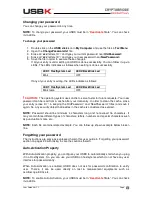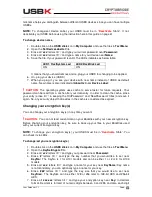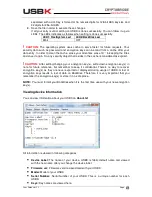
User Guide Ver:1.1 Page:
30
To set your password
Below command is used to set password to USBK in Fabric Default:
#
usbk -u DEVICENAME -c PASSWORD
NOTE:
Password must be minimum 4 characters long and not exceed 16 characters. It may
contain three different types of characters: letters, numbers and special characters such as
punctuation marks, etc.
NOTE:
After new password setting, random encryption key(s) is generated by USBK and
assigned on it. That’s why, it is strongly recommended to set your encryption key(s).
To set your encryption key(s)
After setting your password, the status of USBK is “Deactive” status. Now, you should set
encryption key(s). To set encryption key and key name for a key of USBK, below command
should be used:
#usbk -u DEVICENAME -p PASSWORD -k KEYNO -m KEYNAME -f KEYFORMAT -F
KEYSIZE -x NEWKEY
NOTE:
The “-F” parameter related to AES key size should be either “128” or “256”.
NOTE:
For 128-bit AES key size; encryption key in ‘Text’ type must be 16 characters long
with letters, numbers and special characters such as punctuation marks, etc. Decimal is
formed of 16 numeric digits between 0 and 255, each digit separated with a dot. You can
follow up shown examples below
AES Key
box.
NOTE:
For 256-bit AES key size; encryption key in ‘Text’ type must be 32 characters long
with letters, numbers and special characters such as punctuation marks, etc. Decimal is
formed of 32 numeric digits between 0 and 255, each digit separated with a dot.
NOTE:
USBK can generate and set random encryption key automatically in decimal format.
Below command should be used to set random encryption key:
#usbk -u DEVICENAME -p PASSWOD -k KEYNO -m KEYNAME -F KEYSIZE -X
NOTE:
The random encryption key is generated and set and then the Linux CLI software
shows this encryption key to you. Please note this encryption key down in note to remember
in future
NOTE:
The “-F” parameter related to AES key size should be either “128” or “256”.
!
CAUTION:
After setting/changing your encryption key(s), write down encryption key(s) in
note for future reference, but remember to keep it confidential. There’s no way to recover
encryption key(s) as they are never exported or displayed during usage of USBK. A lost of
encryption keys results in lost of data on BackDisk. Therefore, it is very important that you
remember the encryption key(s) or store it in a safe place.






























